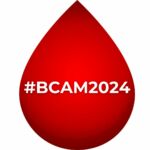Prevention and Treatment of Blood Clots after Hip and Knee Replacement Surgery
Join us Jan. 9, 2024 for our next PEP Talk, Orthopedic Surgery and Blood Clots, to learn how to protect yourself and your loved ones from this potentially fatal complication. This is a must-watch for anyone facing hip or knee replacement surgery.
Register: https://us06web.zoom.us/webinar/register/6716970587222/WN_gI7kUdwVRFqCk-4KYycFfA#/registration
Preventing and treating blood clots after hip and knee replacement surgery is an important part of your recovery. Joint replacement patients are at highest risk for developing a DVT two to 10 days after surgery, and remain at risk for approximately three months.
To prevent blood clots, your doctor will likely prescribe a combination of treatment approaches for you, which may include:
- Exercise/physical therapy beginning the first day after surgery and continuing for several months
- Compression stockings
- Anti-clotting medicine (also known as anticoagulants or blood thinners) to reduce the body’s ability to form blood clots
Exercise or Physical Therapy
You will likely work with a physical therapist to perform specific exercises designed to restore joint range of motion, strengthen your lower body, and improve circulation in your deep veins. For knee replacement, your doctor may recommend using a continuous passive motion (CPM) machine that slowly moves your knee.
Mechanical Prevention Therapies
Graduated compression stockings are graded, meaning they’re tight at the ankle and become looser higher up on the leg. There are also pneumatic, or mechanical, compression devices available. The compression action is thought to help circulation and reduce the risk of blood clots by preventing blood from pooling in the veins. Your doctor may prescribe compression stockings for you or provide details about what type to purchase over-the-counter. Your doctor may also prescribe pneumatic compression devices that use air pumps to massage blood out of the lower leg and back to the heart, similar to compression stockings. These devices can also prevent blood clots by keeping blood from pooling in the legs.
Anti-Clotting Medicine
An anti-clotting medication may be prescribed to prevent blood clots and to treat them. This class of drug is referred to as an anticoagulant, or blood thinner.
Joint replacement patients typically begin to receive anti-clotting medicine the day after surgery, continuing throughout their hospital stay and into at-home rehabilitation. The length of your treatment with anti-clotting medicine and the type of medication you’re prescribed will be determined by your physician and a variety of factors.
There are several types of drugs that fall into the anti-clotting medicine category:
- Heparin: Standard heparin and low molecular weight heparin are given by an injection under the skin. You may be able to give yourself the injections, or have a visiting nurse administer them.
- Warfarin: Your doctor may prescribe warfarin instead of heparin or low molecular weight heparin for blood clot prevention. Warfarin is taken orally in pill form once daily.
- Direct oral anticoagulants: These drugs are the newest type of anti-clotting medicines and are available in a pill form, which are also taken orally once or twice daily depending upon which medication you’re prescribed.
You and your doctor should review your treatment options together, along with their pros and cons and possible side effects. Some of the drugs require adherence to a schedule, careful management of your diet, and regular blood testing. Click here for more specifics about the use of each type of medicine.
Blood Clot Signs and Symptoms
While you’re recovering from your joint replacement surgery, be on the lookout for possible blood clots and contact your physician immediately if you experience any of these signs or symptoms:
Symptoms of Deep Vein Thrombosis (DVT or blood clots in your leg or arm)
- Swelling, usually in one leg (or arm)
- Persistent pain, cramping or tenderness not caused by an injury
- Skin that is warm to the touch
- Redness in skin
If you experience any of these symptoms, call a doctor as soon as you can.
Symptoms of Pulmonary Embolism (PE or blood clots in your lungs)
- Difficulty breathing
- Chest or back pain that worsens with a deep breath
- Coughing, or coughing up blood
A PE can be fatal. If you experience any of these symptoms, call 9-1-1 or seek immediate medical attention.
NBCA’s Stop the Clot® THA/TKA Patient Toolkit was made possible by an educational grant provided by Janssen Pharmaceuticals, Inc.




